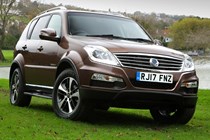
SsangYong Rexton SUV (2016-2017) engines, drive and performance
.jpg)
- One engine available – a 2.2-litre diesel
- Plenty of torque and quiet on a cruise
- Heavy Rexton never feels fast, however
SsangYong has tried hard to improve the Rexton’s performance with this latest model, yet the outcome is still below average compared with its rivals.
The only available engine is a 178hp 2.2-litre turbodiesel and while it’s an upgrade over the previous model’s powerplant, there’s still plenty of room for improvement. It’s not fast – 0-60mph takes 9.9 seconds – but there’s enough shove to keep up with the flow of traffic.
Should you need to overtake another vehicle, however, the 2.1-tonne Rexton begins to struggle. Despite boasting an impressive 400Nm of torque from 1,400rpm, pushing the accelerator pedal to the floor elicits a considerable amount of noise and little gain in speed. To the Rexton’s credit, things do quieten down to acceptable levels once cruising.
Manual and automatic gearbox options
The motor certainly isn’t helped by the optional Mercedes-Benz-sourced seven-speed E-Tronic automatic gearbox which feels as though it’s sapping the engine’s performance. Upshifts and downshifts, while for the most part smooth, often become jerky when rushed.
Any attempt to manually override the gear changes is met by stubborn resistance, each shift taking well over a second to be carried out. Rather confusingly, however, the current gear display responds immediately to the driver’s input, while the changing of ratios itself lags agonisingly behind.
Regardless of which gearbox option you choose, there’s a low-range function on offer to more carefully meter out torque when conditions are very slippery or steep. This means the driver has more control of the vehicle, further bolstering its off-road credentials.
- Better off-road than on it
- Huge three-tonne towing capacity
- Rides well on the motorway
The Rexton’s handling is below the class average on road, yet will be a capable ally in most off-roading situations. We haven’t driven this latest car over the rough stuff, but if the previous generation Rexton is anything to go by it should make short work of tricky terrain.
To help it do this there’s a diff-lock function designed to optimise grip by splitting torque equally between front and rear axles. For those who need to tow heavy trailers, there’s a maximum 750kg unbraked towing weight which increases to 3,000kg for braked towing,
Back on the road, the Rexton’s handling faults are laid bare. Although useful when off-roading, the large amount of steering lock becomes a nuisance on tarmac and means sharp turns require a lot of effort. Faster turns, meanwhile, are blighted by unresponsive steering and inordinate amounts of body roll making the car feel unwieldy and clumsy.
Grip levels are reasonable, yet the Rexton’s reluctance to give any indication as to what the front wheels are doing means it never inspires confidence.


.jpg)
.jpg)
.jpg)
.jpg)
.jpg)
.jpg)
.jpg)
.jpg)
.jpg)
.jpg)
.jpg)
.jpg)
.jpg)
.jpg)
.jpg)

.jpg)
.jpg)

.jpg?quality=50)
.jpg?quality=50)
.jpg?quality=50)
.jpg?quality=50)
.jpg?quality=50)
.jpg?quality=50)
.jpg?quality=50)
.jpg?quality=50)
.jpg?quality=50)
.jpg?quality=50)
.jpg?quality=50)
.jpg?quality=50)
.jpg?quality=50)
.jpg?quality=50)
.jpg?quality=50)
.jpg?quality=50)
.jpg?quality=50)